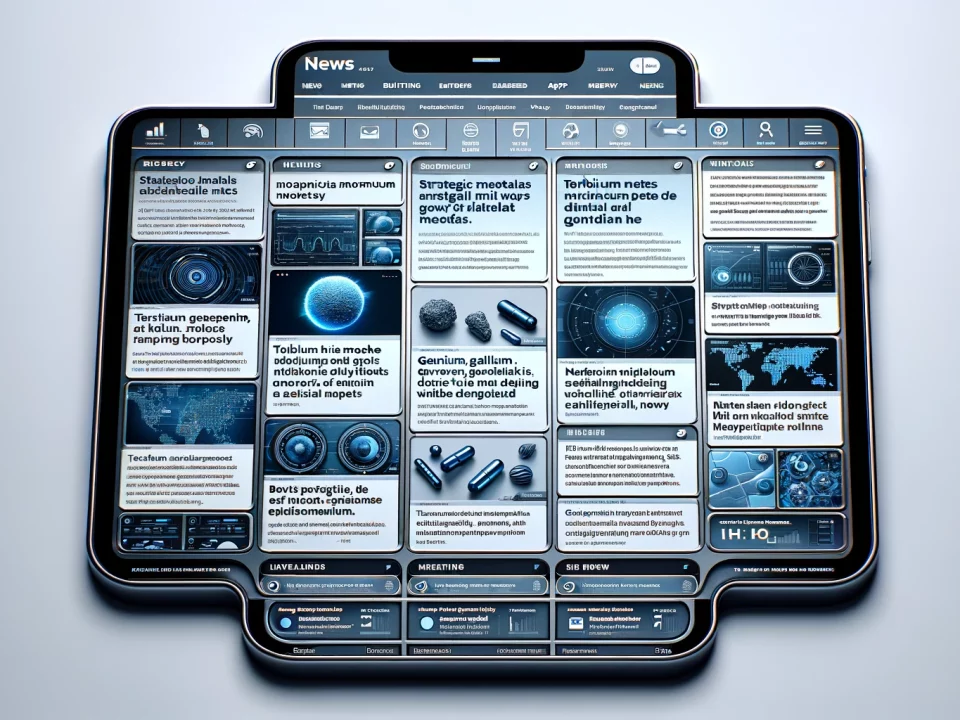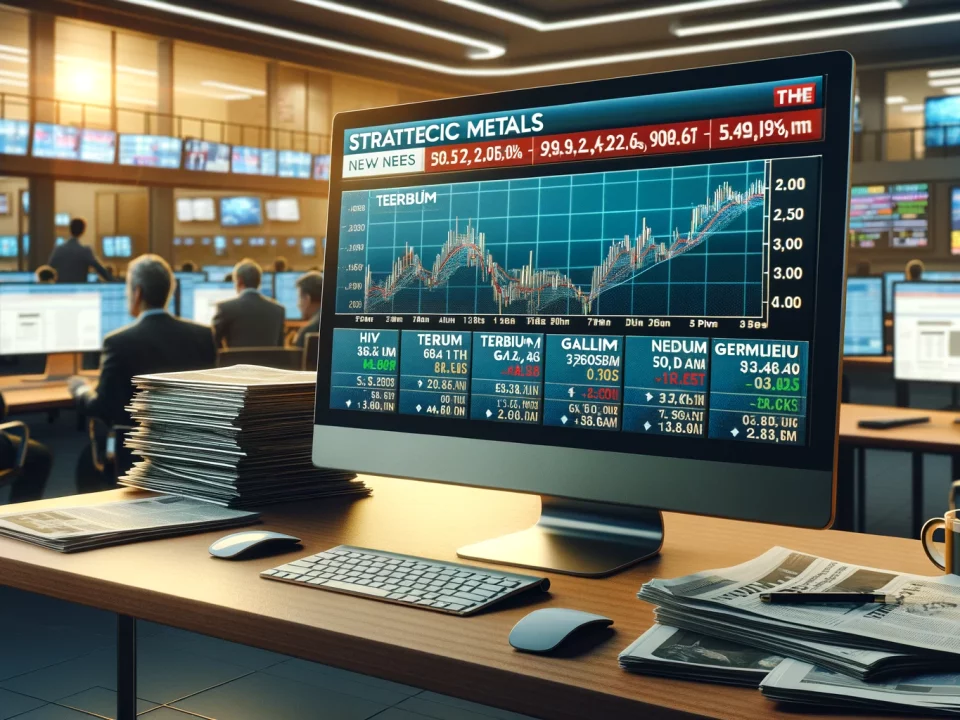
Weekly News Review Jan 22-28 2024
January 28, 2024China Issues Rare Earth Production Quota
February 6, 2024There are lots of interesting developments to report this week as we head into the first week in February. Let’s begin in North America when…
On Wednesday, the U.S. Geological Survey published its annual Mineral Commodity Summaries, the first comprehensive overview of the production and demand for mineral commodities in the past year. The annual publication is also dedicated to resource policy and provides essential information on the global reserves of more than 90 commodities, excluding fuels such as coal and natural gas.
The report provides an overview of more than 90 commodities.
In 2023, raw materials worth 105 billion US dollars were produced in the USA, an increase of four per cent compared to 2022. Nevertheless, the data now presented shows the country’s heavy dependence on imports, particularly in the case of gallium, indium, scandium yttrium, and eleven other commodities.
The most important countries of origin – representing imports of more than 50 per cent of a particular raw material – are China, Canada, Germany, Brazil, Belgium, Mexico, Russia, and South Africa. For example, the USA covers 100 per cent of its demand for the alkali metal caesium through imports from Germany, which is also a major supplier of rubidium and other technology metals to the USA.
The USGS has also published new estimates of the volume of rare earth deposits in the most important countries of origin, including a downward revision of the US’s own estimates. The adjustments are particularly significant for Russia, which, according to the agency, now has reserves of 10 million tons instead of 21 million tons. According to the calculations, Australia’s reserves are more extensive than previously assumed. This is good news for the country, which is increasingly seeking to establish itself as an alternative to industry leader China.
Also, in the US, the Pentagon is tapping into AI to increase strategic metals market transparency.
The Open Price Exploration for National Security (OPEN) program aims to facilitate price, supply, and demand forecasts by developing technologies like machine learning models.
The Defense Advanced Research Projects Agency (DARPA), a research and development agency of the U.S. Department of Defense, is seeking ways to increase transparency in the critical minerals and raw materials markets. The Pentagon argues that issues regarding pricing and inaccurate supply and demand forecasts threaten the readiness of the department to respond to supply chain challenges, according to the press release published in October, which received little attention then, according to Reuters.
To address these issues, DARPA announced a partnership with the U.S. Geological Survey to facilitate the development of helpful technology. The Open Price Exploration for National Security (OPEN) program plans to analyze commercially and publicly available cost information to construct transparent structural price predictions and use advances in time series forecasting, economic modelling, and machine learning to create accurate and precise supply and demand forecasts. A presentation describing the program stated the project’s goal to “revolutionize the construction and dissemination of price, supply, and demand predictions and forecasts.
The OPEN press release added that critical materials producers and buyers may use the estimates OPEN publishes as a transparent information source However, documents retrieved by Reuters clarify that the Pentagon’s efforts are “not intended to set an official U.S. government metals price or replace the London Metal Exchange (LME) and other futures markets.”
Continuing in Washinton, THE US AND EU TALKS FAIL TO REACH AN AGREEMENT ON STRATEGIC METALS –
In 2021, EU and U.S. representatives created the Trade and Technology Council (TTC) to strengthen and steer transatlantic cooperation on trade and global challenges.
Yesterday, the TTC held its fifth meeting in Washington, D.C.
Topics of the meeting were, among other fields, artificial intelligence, secure supply chains, and the green transition, according to a press statement by the EU.
However, according to Reuters, the representatives disagreed on critical minerals needed for battery production. The news agency quotes European Commission Executive Vice President Valdis Dombrovskis, who sees “outstanding issues” on the European side, especially regarding green energy subsidies under the U.S. Inflation Reduction Act (IRA).
An agreement would have provided European carmakers access to electric vehicle tax credits under the IRA, making them more competitive.
Dombrovskis, however, vowed to press on:
“We are willing to continue this engagement and eventually a comprehensive agreement.”
The representatives agreed to hold a sixth meeting in April in Belgium.
The TTC will hold a stakeholder event on Crafting the Transatlantic Green Marketplace later today to allow members to discuss the topics further and present views and proposals.
The event will also hold workshops on the transition to green energy, solar supply chains, and permanent magnets.
And now to Estonia in Europe…
Australian mining group Hastings Technology Metals is looking into building up processing capacities.
Rare earths from Australia, processed in Estonia into components for the European automotive industry – that is the goal of Hastings Technology Metals. Next year, the Perth-based company will begin mining rare earths in the north of Western Australia and processing them into mixed concentrate, one of the first stages of processing this group of raw materials. This and other future steps could also take place in the Baltic region, as Hastings has announced (PDF) that it will carry out feasibility studies in cooperation with the Estonian government to set up corresponding plants. A non-binding letter of intent has been signed to speed up planning and approval procedures and explore the possibility of financial support from the state.
Hastings sees Estonia as a crucial building block for developing a supply chain tailored to Europe, from the mine to the magnet. Here, the Canadian company Neo Performance Materials operates the only plant separating rare earths in Europe. The construction of a magnet factory is planned, and Hastings, in turn, holds a 21.15 per cent stake in Neo. Both companies have signed a non-binding agreement to supply and process rare earths from Hastings’ Yangibana project in Western Australia.
Australia’s resources minister visited South Korea and Japan this week to discuss investment opportunities. The trip is accompanied by the government releasing a catalogue of 52 investment-ready projects.
Australia continuously seeks new international partnerships under its recently unveiled Critical Minerals Strategy to develop strategic projects and leverage its natural resources. To this effect, resources minister Madeleine King will visit Australia’s second and third largest export markets for resources and energy, Japan and South Korea, this week. According to a press release, King will meet with trade ministers from both countries in the capitals of Tokyo and Seoul and afterwards convene with executives from major industries and utilities.
Australia already has critical minerals partnerships with both countries, and the visit will “reinforce Australia’s role as a stable and reliable export partner,” King said. Australia and Japan have been collaborating under the Japan-Australia Critical Minerals Partnership since 2022. South Korea and Australia signed the Memorandum of Understanding on Cooperation in Critical Mineral Supply Chains in late 2021.
King’s visit to the two Asian countries is accompanied by the Australian Government unveiling a “prospectus” of 52 investment-ready critical minerals projects. The aptly named Australian Critical Minerals Prospectus (PDF) highlights investment opportunities in projects across the critical mineral supply chain, from mining to processing and other value-adding fields. The prospectus will also be released in Korean and Japanese, highlighting the importance of the two countries for Australia’s critical mineral sector…
..and now, what could be regarded as the biggest news item of the week.
Australian media is reporting a rumoured mega-merger between MP Minerals, USA and Lynas Corp, Australia.
Business newspapers report indications of increased cooperation between rare earth specialists.
The Australian Financial Review writes that the most important rare earth miners outside China, MP Materials from the U.S. and the Australian group Lynas, could join forces, citing industry insiders. However, according to the country’s most important business newspaper, it is unclear what such a deal could look like. The USA and Australia want to expand their cooperation in critical minerals, for which the Climate, Critical Minerals, and Clean Energy Transformation Compact was concluded in May last year.
Lynas’ expertise in processing rare earths is already a building block in the U.S. strategy for greater autonomy in the supply of rare earths. The company is building a refinery for these raw materials in South Texas on behalf of the Department of Defense. According to Lynas, the plant will initially process material that Lynas extracts from the Mount Weld mine in Australia but will also be able to process resources from other suppliers (PDF). Possibly also those from MP Materials’ Mountain Pass mine 2,300 kilometres away in California.
So far, the companies have not commented on the rumours of a potential collaboration. Meanwhile, MP will present its quarterly figures on February 22, and the industry whispers will likely be a topic at the press conference.
That’s all we’ve got for this week. As always, please reach out if you want to learn more.






